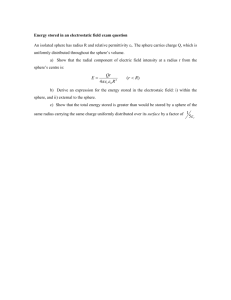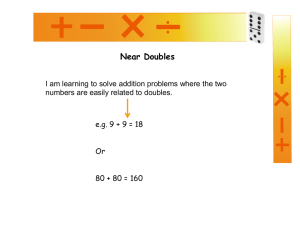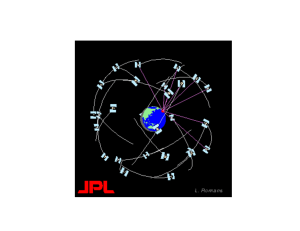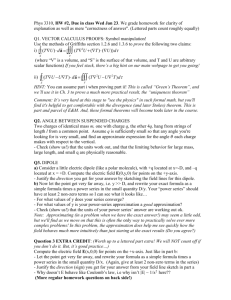Consider the assembly of 4 spherical, globular macromolecules
advertisement
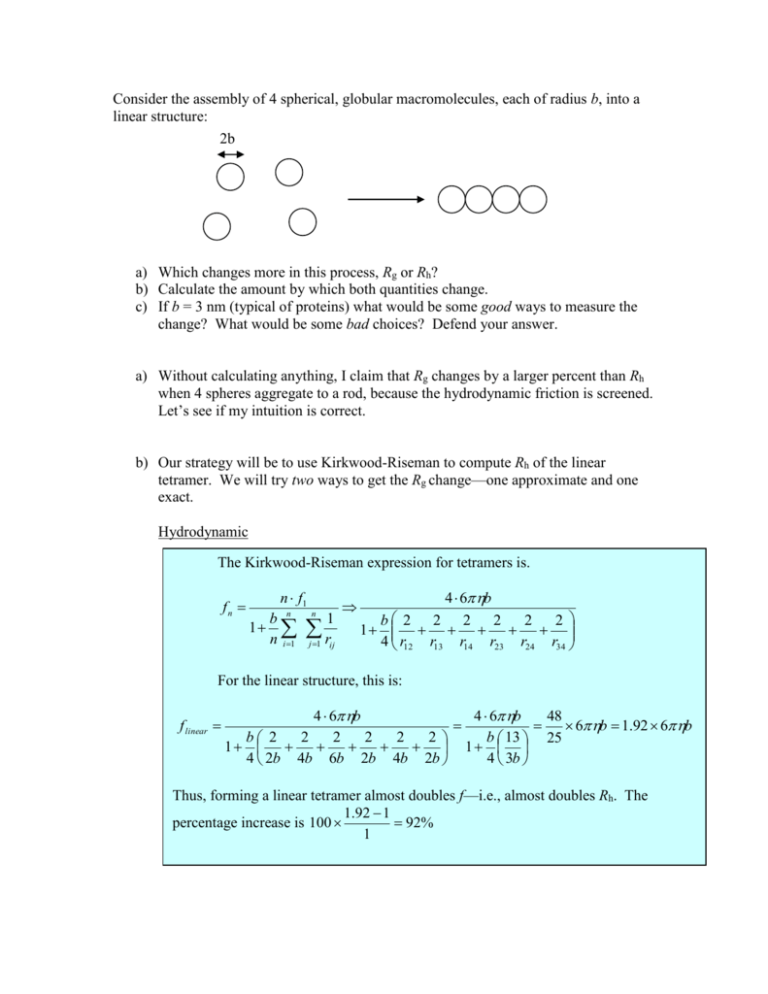
Consider the assembly of 4 spherical, globular macromolecules, each of radius b, into a linear structure: 2b a) Which changes more in this process, Rg or Rh? b) Calculate the amount by which both quantities change. c) If b = 3 nm (typical of proteins) what would be some good ways to measure the change? What would be some bad choices? Defend your answer. a) Without calculating anything, I claim that Rg changes by a larger percent than Rh when 4 spheres aggregate to a rod, because the hydrodynamic friction is screened. Let’s see if my intuition is correct. b) Our strategy will be to use Kirkwood-Riseman to compute Rh of the linear tetramer. We will try two ways to get the Rg change—one approximate and one exact. Hydrodynamic The Kirkwood-Riseman expression for tetramers is. fn n f1 1 n b n i 1 n 1 r j 1 ij 4 6b b 2 2 2 2 2 2 1 4 r12 r13 r14 r23 r24 r34 For the linear structure, this is: f linear 4 6b 4 6b 48 6b 1.92 6b b 2 2 2 2 2 2 b 13 25 1 1 4 2b 4b 6b 2b 4b 2b 4 3b Thus, forming a linear tetramer almost doubles f—i.e., almost doubles Rh. The 1.92 1 92% percentage increase is 100 1 Radius of Gyration The wimpy, easy way is to treat the linear tetramer as 4 point masses: Center of mass This affords a very easy estimate of Rg: Rg 2(b 2 ) 2(3b 2 ) b 5 2.24b 4 Since the original Rg is b 3 / 5 the increase is by a factor of the Rg almost triples. The percentage change is 100 5 3/ 5 5 3/ 5 3/ 5 2.89 . Thus, 189% . Summary Rg almost triples in this process, while Rh almost doubles. As expected, the change is bigger in Rg. Doing the Rg part right Our assumption that each sphere in the linear aggregate could be modeled as a point mass eliminates from consideration some mass elements that lie beyond the centers. Consider sphere 4, whose center is at 3b from the overall center of mass. Some elements lie beyond the distance 3b….and there are some closer than 3b. 3b The “inner” volume elements do not cancel the “outer” ones. We expect that the outer ones contribute more because of the effect of the squaring. Thus, our previous estimate of Rg must be too small. How should we do this right? Let’s compute the contribution from a sphere whose center is located a distance A away from the overall center of mass. We construct both an x,y,z and spherical polar coordinate system, as shown. The vector, s, connecting a volume element from the center of mass is given by: s A r Azˆ r z r y x s A C.M. So….what you have to do is compute the contribution of this sphere to Rg. That’s going to look like this: (s s)dV ( A 2 s 2contribution V V 2 Ar cos r 2 )dV V V So…dV = r2sindrddas usual for spherical polar coordinates. Thus: 2 s 2 contribution b 0 ( A2 2 Ar cos r 2 )r 2 sin dddr 0 r 0 4 3 b 3 See if you can evaluate the integrals (three of them, one is zero) to get: 3 s 2 contribution A2 b 2 5 Note that when A = 0, s2 = 3b2/5, as expected for a sphere on center. The four spheres of our linear, tetrameric aggregate fall into two groups—two with A = b and two with A = 3b. So, all four contributions sum to: 3 3 12 2(b 2 b 2 ) 2((3b) 2 b 2 ) b 2 (2 18 ) 5 5 5 5.6b 2 s2 4 4 So, the true radius of gyration of the linear tetrameric aggregate is: Rg,linear tetramer b 5.6 2.37b and not the 2.24b we estimated by imagining point masses. The point mass assumption produced an error of about 7%. c) Regarding good and bad methods to detect these changes, it should be said that either static or dynamic scattering methods have the necessary precision to do the job…but if the parent structure is only 3 nm, your static LS method would have to be x-ray or neutron based. Thus, SAXS or SANS could pick up the changes in Rg. Visible light scattering will not work. Changes in Rh could be measured easily by DLS, DOSY or analytical ultracentrifugation. One bad choice for the hydrodynamic measurement would be intrinsic viscosity.


